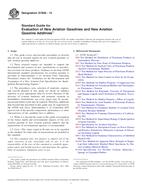Wir benötigen Ihre Einwilligung zur Verwendung der einzelnen Daten, damit Sie unter anderem Informationen zu Ihren Interessen einsehen können. Klicken Sie auf "OK", um Ihre Zustimmung zu erteilen.
ASTM D7826-13
Standard Guide for Evaluation of New Aviation Gasolines and New Aviation Gasoline Additives
Automatische name übersetzung:
Standard-Handbuch für die Bewertung von neuen Flugbenzin und Flugbenzin New Additives
NORM herausgegeben am 15.10.2013
Informationen über die Norm:
Bezeichnung normen: ASTM D7826-13
Anmerkung: UNGÜLTIG
Ausgabedatum normen: 15.10.2013
SKU: NS-39157
Zahl der Seiten: 20
Gewicht ca.: 60 g (0.13 Pfund)
Land: Amerikanische technische Norm
Kategorie: Technische Normen ASTM
Die Annotation des Normtextes ASTM D7826-13 :
Keywords:
additive evaluations, additive qualifications, alternative fuels, approval protocols, ASTM International, aviation gasolines, fuel additives, fuel evaluations, fuel qualifications, material compatibility, ICS Number Code 75.160.20 (Liquid fuels)
Ergänzende Informationen
| Significance and Use | ||||||||||||||||||||||||||||||||||||||||||||||||||||||||||||||||||||||||||||||||||||||||||||||||||||||||||||||||||||||
|
5.1 This guide is intended for the developers or sponsors of new aviation gasolines or additives to describe the data requirements necessary to support the review of these new products by ASTM members. 5.2 This guide is not an approval process. It is intended to describe test and analysis requirements necessary to generate data to support specification development. This guide does not address the approval process for ASTM International standards. 5.3 This guide will reduce the uncertainty and risk to developers or sponsors of new aviation gasolines or additives by describing the test and analysis requirements necessary to proceed with the development of an ASTM International specification for aviation gasoline or specification revision for an aviation gasoline additive. 5.4 This guide does not purport to specify an all-inclusive listing of test and analysis requirements to achieve ASTM International approval of a specification or specification revision. The final requirements will be dependent upon the specific formulation and performance of the candidate fuel and be determined by the ASTM International task forces and committees charged with overseeing the specification development. 5.5 This guide does not describe data requirements of other approving authorities, such as national aviation regulatory authorities, or of other organizations or industry associations. However, the data generated in the conduct of the procedure may be useful for other purposes or other organizations. 5.6 Over 200 000 piston-engine aircraft rely on Specification D910 lead-containing aviation gasoline (avgas) for safe operation. There has been an increase in the research and development of alternatives to Specification D910 gasolines as a result of environmental and economic concerns. |
||||||||||||||||||||||||||||||||||||||||||||||||||||||||||||||||||||||||||||||||||||||||||||||||||||||||||||||||||||||
| 1. Scope | ||||||||||||||||||||||||||||||||||||||||||||||||||||||||||||||||||||||||||||||||||||||||||||||||||||||||||||||||||||||
|
1.1 This guide covers and provides procedures to develop data for use in research reports for new aviation gasolines or new aviation gasoline additives. 1.2 These research reports are intended to support the development and issuance of new specifications or specification revisions for these products. Guidance to develop ASTM International standard specifications for aviation gasoline is provided in Subcommittee J on Aviation Fuels Operating Procedures, Annex A6, “Guidelines for the Development and Acceptance of a New Aviation Fuel Specification for Spark-Ignition Reciprocating Engines.” 1.3 The procedures, tests, selection of materials, engines, and aircraft detailed in this guide are based on industry expertise to give appropriate data for review. Because of the diversity of aviation hardware and potential variation in fuel/additive formulations, not every aspect may be encompassed and further work may be required. Therefore, additional data beyond that described in this guide may be requested by the ASTM task force, Subcommittee J, or Committee D02 upon review of the specific composition, performance, or other characteristics of the candidate fuel or additive. 1.4 While it is beyond the scope of this guide, investigation of the future health and environmental impacts of the new aviation gasoline or new aviation gasoline additive and the requirements of environmental agencies is recommended. 1.5 Units—The values stated in SI units are to be regarded as the standard. No other units of measurement are included in this standard. 1.6 This standard does not purport to address all of the safety concerns, if any, associated with its use. It is the responsibility of the user of this standard to establish appropriate safety and health practices and determine the applicability of regulatory limitations prior to use. |
||||||||||||||||||||||||||||||||||||||||||||||||||||||||||||||||||||||||||||||||||||||||||||||||||||||||||||||||||||||
| 2. Referenced Documents | ||||||||||||||||||||||||||||||||||||||||||||||||||||||||||||||||||||||||||||||||||||||||||||||||||||||||||||||||||||||
|
Empfehlungen:
EEviZak – alle Gesetze einschließlich ihrer Evidenz in einer Stelle
Bereitstellung von aktuellen Informationen über legislative Vorschriften in der Sammlung der Gesetze bis zum Jahr 1945.
Aktualisierung 2x pro Monat!
Brauchen Sie mehr Informationen? Sehen Sie sich diese Seite an.




 Cookies
Cookies
